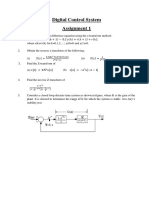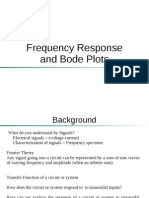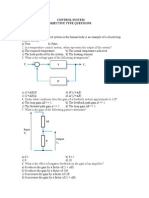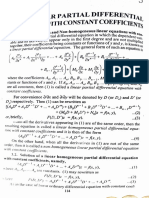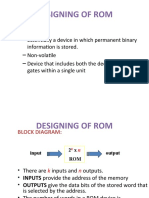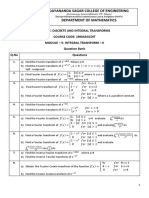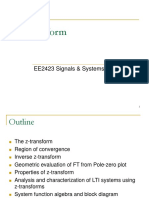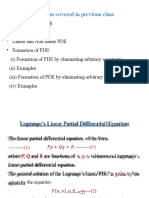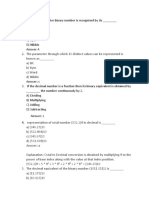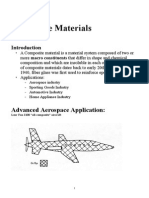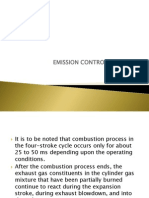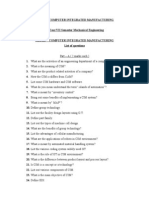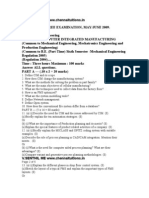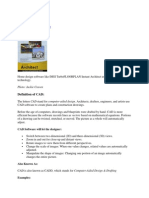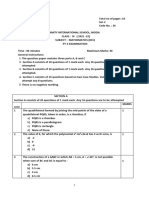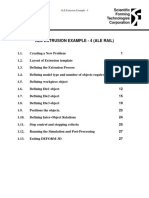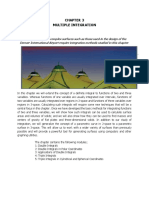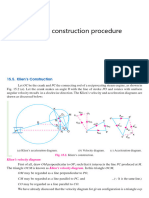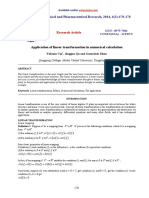Engineering Mathematic-II
UNIT-I
ORDINARY DIFFERENTIAL EQUATIONS:
2 3 2
( ) ( )
( ) ; ( ) , , , , tan
D y f x
D is aD bD c or aD bD cD d where a b c d are cons ts
+ + + + +
1. ODE with constant coefficients: Solution
C.F+P.I y
Complementary functions: (C.F.)
Sl.No. Nature of Roots C.F
1.
1 2
m m ( )
mx
Ax B e +
2.
1 2 3
m m m
( )
2 mx
Ax Bx c e + +
3.
1 2
m m
1 2
m x m x
Ae Be +
4.
1 2 3
m m m
3 1 2
m x m x m x
Ae Be Ce + +
5.
1 2 3
, m m m
3
( )
m x mx
Ax B e Ce + +
6. m i t
( cos sin )
x
e A x B x
+
7. m i t cos sin A x B x +
Particular Integral: (P.I.)
Type-I
If
( ) 0 f x
then, P.I = 0.
Type-II
If ( )
ax
f x e
1
.
( )
ax
P I e
a
Replace D by a. If
( ) 0 a
, then it is P.I. If
( ) 0 a
, then diff. denominator
w.r.t D and multiply x in numerator. Again replace D by a. If you get denominator again
zero then do the same procedure.
Type-III
Case: (i) If
( ) sin ( ) cos f x ax or ax
1
. sin (or) cos
( )
P I ax ax
D
Here you have to replace only
2
D
not D.
2
D
is replaced by
2
a . If the
denominator is equal to zero, then apply same procedure as in Type-II.
Case: ii If
2 2 3 3
( ) (or) cos (or) sin (or) cos f x Sin x x x x
Use the following formulas
2
1 cos 2
2
x
Sin x
,
2
1 cos 2
cos
2
x
x
+
,
( )
3
1
sin 3sin sin3
4
x x x , ( )
3
1
cos 3cos cos3
4
x x x + and separate
1 2
. & . P I P I
Case: iii If
( ) sin cos ( ) cos sin ( ) cos cos ( ) sin sin f x A B or A B or A B or A B
Use the following formulas:
( )
( )
( )
( )
1
( ) in cos ( ) sin( )
2
1
(ii) cos sin ( ) sin( )
2
1
( ) cos cos cos( ) cos( )
2
1
( ) sin sin cos( ) cos( )
2
i s A B sin A B A B
A B Sin A B A B
iii A B A B A B
iv A B A B A B
+ +
+
+ +
+
Type-IV
If ( )
m
f x x
1
.
( )
m
P I x
D
1
1 ( )
m
x
g D
+
( )
1
1 ( )
m
g D x
+
Here we can use Binomial formula as follows:
i) ( )
1
2 3
1 1 ... x x x x
+ + +
ii) ( )
1
2 3
1 1 ... x x x x
+ + + +
iii) ( )
2
2 3
1 1 2 3 4 ... x x x x
+ + +
iv) ( )
2
2 3
1 1 2 3 4 ... x x x x
+ + + +
v)
3 2 3
(1 ) 1 3 6 10 ... x x x x
+ + +
vi)
3 2 3
(1 ) 1 3 6 10 ... x x x x
+ + + +
Type-V
If ( )
ax
f x e V where sin , cos ,
m
V ax ax x
1
.
( )
ax
P I e V
D
Take out
ax
e and replace D by D+a.
1
( )
ax
e V
D a
+
Type-VI
If ( )
n
f x x V where
sin , cos V ax ax
sin I.P of
cos R.P of
iax
iax
ax e
ax e
1. ODE with variable co-efficients : (Eulers Method)
The equation is of the form
2
2
2
( )
d y dy
x x y f x
dx dx
+ +
Implies that
2 2
( 1) ( ) x D xD y f x + +
To convert the variable coefficients into the constant coefficients
Put
log z x
implies
z
x e
2 2
3 3
( 1)
( 1)( 2)
xD D
x D D D
x D D D D
where
d
D
dx
and
d
D
dz
The above equation implies that ( ) ( 1) 1 ( ) D D D y f x + +
which is O.D.E
with constant coefficients.
2. Legendres Linear differential equation:
The equation if of the form
2
2
2
( ) ( ) ( )
d y dy
ax b ax b y f x
dx dx
+ + + +
Put Z =
log( ) ax b +
, then ( )
z
ax b e +
2 2 2
3 3 3
( )
( ) ( 1)
( ) ( 1)( 2)
ax b D aD
ax b D a D D
ax b D a D D D
+
+
+
where
d
D
dx
and
d
D
dz
UNIT-II
VECTOR CALCULUS:
1. Vector differential operator is / / / i x j y k z + +
r r r
2. Gradient of
/ / / i x j y k z + +
r r r
3. Divergence of
F
r
3 1 2
1 2 3
,
F F F
F where F Fi F j F k
x y z
+ + + +
r r r r r
g
4. Curl of
F
r
1 2 3
/ / /
i j k
XF x y z
F F F
r r r
r
5. If
F
r
is a Solenoidal vector then
0 F
r
g
6.
7. If
F
r
is an Irrotational vector, then
0 XF
r
8. Maximum Directional derivative
9. Directional derivative of
in the direction of a
r
a
a
r
g
r
10. Angle between two normals to the surface
1 2
1 2
cos
n n
n n
r r
g
r r
Where
( )
1 1 1
1 1
( , , ) at x y z
n
r
&
( )
2 2 2
2 2
( , , ) at x y z
n
r
11. Unit Normal vector,
n
12. Equation of the tangent plane
1 1 1
( ) ( ) ( ) 0 l x x m y y n z z + +
at
1 1 1
( , , ) x y z
on
the surface
( , , ) 0 x y z
. Here l, m, n are coefficients of , , i j k
r r r
in
.
13. Equation of normal line
1 1 1
x x y y z z
l m n
14. Work Done =
C
F dr
r
r
g
, where dr dxi dyj dzk + +
r r r
r
15. If
.
C
F dr
r
r
is independent of the path then
curl 0 F
r
16. In the surface integral,
.
dxdy
dS
n k
r
,
.
dydz
dS
n i
r
,
.
dzdx
dS
n j
r
& dS ndS
r
17. Greens Theorem:
If
, , ,
u v
u v
y x
are continuous and one-valued functions in the region R enclosed
by the curve C, then
C R
v u
udx vdy dxdy
x y
_
+
,
.
18. Stokes Theorem:
Let
F
r
be the vector point function, defined over an open surface bounded by a
closed curve C, then
( )
x
C S
F dr F nds
r r
r
g g
19. Gauss Divergence Theorem:
Let
F
r
be a vector point function in a region R bounded by a closed surface S,
then
S V
F nds Fdv
r r
g g
UNIT-III
ANALYTIC FUNCTIONS:
1. Necessary conditions for f(z) to be an analytic function are the
Cauchy Riemann Equations;
&
u v u v
x y y x
(OR)
X Y Y X
U V and U V
(C-R equations)
2. The Polar form of Cauchy-Riemann Equations:
1 1
&
u v v u
r r r r
3. The function u(x,y) is said to be harmonic if it satisfies the
Laplace equation :
2 2
2 2
0
u u
x y
+
4. If the function is harmonic then it should be either real or imaginary part of some
analytic function.
5. Milne Thomson method: for (finding the analytic function f(z) if the real or
imaginary part is given
i) If u is given
( ) ( , 0) ( , 0)
x y
f z u z dz i u z dz
ii) If v is given
( ) ( , 0) ( , 0)
y x
f z v z dz i v z dz +
6. To find the analytic function
i)
( ) ; ( ) f z u iv if z iu v +
adding these two
We have
( ) ( ) (1 ) ( ) u v i u v i f z + + +
then
( ) F z U iV +
where
, & ( ) (1 ) ( ) U u v V u v F z i f z + +
Here we can apply Milne Thomson method for F(z).
7. Bilinear transformation is ; 0
az b
w ad bc
cz d
+
+
8. The cross-ration of 4 pts
( ) ( )
( ) ( )
1 2 3 4
1 2 3 4 1 2 3 4
2 3 4 1
, , , ( , , , )
z z z z
z z z z is z z z z
z z z z
9. The cross-ratio is invariant under a bilinear transformation
( ) ( )
( ) ( )
( ) ( )
( ) ( )
1 2 3 1 2 3
1 2 3 1 2 3
w w w w z z z z
w w w w z z z z
UNIT-IV
COMPLEX INTEGRATION:
1. Cauchys Integral Theorem:
If f(z) is analytic and
( ) f z
is continuous inside and on a simple closed curve C,
then
( ) 0
c
f z dz
.
2. Cauchys Integral Formula:
If f(z) is analytic within and on a simple closed curve C and a is any point inside
C, then
( )
2 ( )
C
f z
dz if a
z a
3. Cauchys Integral Formula for derivatives:
If a function f(z) is analytic within and on a simple closed curve C and a is any
point lying in it, then
( )
2
1 ( )
( )
2
C
f z
f a dz
i
z a
Similarly
( )
3
2! ( )
( )
2
C
f z
f a dz
i
z a
, In general
( )
( )
1
! ( )
( )
2
n
n
C
n f z
f a dz
i
z a
4. Cauchys Residue theorem:
If f(z) is analytic at all points inside and on a simple closed cuve c, except for a
finite number of isolated singularities
1 2 3
, , ,...
n
z z z z
inside c, then
{ }
1 1
( ) 2 (sum of the residues of ( )) 2 Re ( ) Re ( )
z z z z
C
f z dz i f z i s f z s f z
+ +
.
5. Critical point:
The point, at which the mapping w = f(z) is not conformal, (i.e)
( ) 0 f z
is called
a critical point of the mapping.
6. Fixed points (or) Invariant points:
The fixed points of the transformation
az b
w
cz d
+
+
are obtained by putting w = z
in the above transformation, the point z = a is called fixed point.
7.
Re { ( )} ( ) ( )
z a z a
s f z Lt z a f z
(Simple pole)
8. ( )
( )
1
1
1
Re { ( )} ( )
( 1)!
m
m
m
z a z a
d
s f z Lt z a f z
m dz
(Multi Pole (or) Pole of order m)
9. Taylor Series:
A function
( ) f z
, analytic inside a circle C with centre at a, can be expanded in the
series
2 3
( )
( ) ( ) ( ) ( )
( ) ( ) ( ) ( ) ( ) ... ( ) ...
1! 2! 3! !
n
n
z a z a z a z a
f z f a f a f a f a f a
n
+ + + + + +
Maclaurins Series:
Taking a = 0, Taylors series reduce to
2 3
( ) (0) (0) (0) (0) ...
1! 2! 3!
z z z
f z f f f f + + + +
10. Laurents Series:
0 1
( ) ( )
( )
n n
n n
n n
b
f z a z a
z a
+
The part
1
( )
n
n
n
b
z a
is called the Principal part
where
1
1
1 ( )
2 ( )
n n
C
f z
a dz
i z a
+
&
2
1
1 ( )
2 ( )
n n
C
f z
b dz
i z a
, the integrals being
taken anticlockwise around
1 2
C and C
.
11. Isolated Singularity:
A point
0
z z
is said to be an isolated singularity of
( ) f z
if
( ) f z
is not analytic
at
0
z z
and there exists a neighborhood of
0
z z
containing no other singularity
of f(z). Example:
1
( ) f z
z
. This function is analytic everywhere except at
0 z . 0 z is an isolated singularity of f(z).
12. Removable Singularity:
A singular point
0
z z
is called a removable singularity of
( ) f z
if
0
lim ( ) f z
z z
exists finitely.
Example:
sin
lim ( ) lim 1
0 0
z
f z
z
z z
(finite) 0 z is a removable
singularity.
13. Essential Singularity:
If the principal part contains an infinite number of non zero terms, then
0
z z
is
known as an essential singularity.
Example:
( )
2
1
1/ 1/
( ) 1 ...
1! 2!
z
z z
f z e + + +
has 0 z as an essential
singularity.
CONTOUR INTEGRATION:
14. Type: I
To evaluate the integrals of the form
2
0
(cos , sin ) f d
Here we shall choose
the contour (closed curve) as the unit circle
: 1, , 0 2
i
C z Put z e
.
Then
2
1
cos
2
z
z
+
,
2
1
sin
2
z
iz
and
1
d dz
iz
.
15. Type: II
To evaluate integrals of the form
( )
( )
P x
dx
Q x
, Here P(x) and Q(x) are polynomials
in x such that the degree of Q exceeds that of P at least by two and Q(x) does not
vanish for any x. Choose the closed curve C consisting of the following parts.
(i) the semi circle
: Z R
in the upper half plane.
(ii) The line segment [-R, R] on the real axis.
Here
( ) ( ) ( )
R
C R
f z dz f x dx f z dz
+
as
( ) 0 R f z dz
.
Where,
( )
( )
( )
P z
f z
Q z
16. Type: III
The integrals of the form ( ) cos (or) ( )sin f x mxdx f x mxdx
where
( )
( )
( )
P x
f x
Q x
as in Type II.
Use cos . . , sin . .
imx imx
mx R P of e mx I P of e Proceed as in Type II.
UNIT-V
LAPLACE TRANSFORM:
1. Definition: [ ]
0
( ) ( )
st
L f t e f t dt
2.
Sl.No Nature of Roots C.F
1. [ ] 1 L
1
s
2.
n
L t 1
] 1 1
! ( 1)
n n
n n
s s
+ +
+
3.
at
L e 1
]
1
s a
4.
at
L e
1
]
1
s a +
5. [ ] sin L at
2 2
a
s a +
6. [ ] cos L at
2 2
s
s a +
7. [ ] sinh L at
2 2
a
s a
8. [ ] cosh L at
2 2
s
s a
3. Linear Property: [ ] [ ] [ ] ( ) ( ) ( ) ( ) L af t bg t aL f t bL g t t t
4. First Shifting property:
If [ ] ( ) ( ) L f t F s
, then
i) [ ] ( ) ( )
at
s s a
L e f t F s
1
]
= F(s-a)
ii) [ ] ( ) ( )
at
s s a
L e f t F s
+
1
]
= F(s+a)
5. Second Shifting property:
If [ ] ( ) ( ) L f t F s
,
( ),
( )
0,
f t a t a
g t
t a
>
'
<
then [ ] ( ) ( )
as
L g t e F s
6. Change of scale:
If [ ] ( ) ( ) L f t F s
, then [ ]
1
( )
s
L f at F
a a
_
,
7. Transform of the function multiplied by t or t
2
If [ ] ( ) ( ) L f t F s
, then [ ] ( ) ( )
d
L tf t F s
ds
,
2
2
2
( ) ( )
d
L t f t F s
ds
1
]
,
In general ( ) ( 1) ( )
n
n n
n
d
L t f t F s
ds
1
]
8. Transform of the function divided by t
If [ ] ( ) ( ) L f t F s
, then
1
( ) ( )
s
L f t F s ds
t
1
]
9. Initial value Theorem:
If [ ] ( ) ( ) L f t F s
, then
( ) ( )
0 s
Lt f t Lt sF s
t
10. Final value Theorem:
If [ ] ( ) ( ) L f t F s
, then
( ) ( )
s 0
Lt f t Lt sF s
t
11.
Sl.No
1.
1
1
L
s
1
1
]
1
2.
1
1
L
s a
1
1
]
at
e
3.
1
1
L
s a
1
1
+
]
at
e
4.
1
2 2
s
L
s a
1
1
+
]
cos at
5.
1
2 2
1
L
s a
1
1
+
]
1
sin at
a
6.
1
2 2
s
L
s a
1
1
]
cosh at
7.
1
2 2
1
L
s a
1
1
]
1
sinh at
a
8.
1
1
n
L
s
1
1
]
1
( 1)!
n
t
n
12. Deriative of inverse Laplace Transform:
[ ] [ ]
1 1
1
( ) ( ) L F s L F s
t
13. Colvolution of two functions:
0
( ) ( ) ( ) ( )
t
f t g t f u g t u du
14. Covolution theorem:
If f(t) & g(t) are functions defined for 0 t then [ ] [ ] [ ] ( ) ( ) ( ) ( ) L f t g t L f t L g t
15. Convolution theorem of inverse Laplace Transform:
[ ]
1
0
( ) ( ) ( ) ( )
t
L F s G s f u g t u du
16. Solving ODE for second order differential equations using L.T
i) [ ] [ ] ( ) ( ) (0) L y t sL y t y
ii) [ ] [ ]
2
( ) ( ) (0) (0) L y t s L y t sy y
iii) [ ] [ ]
3 2
( ) ( ) (0) (0) (0) L y t s L y t s y sy y
17. Laplace Transform:
If f(x+T) = f(x), then f(x) is said to be a of Periodic function with period T.
For such a periodic function, the Laplace Transformation is given by
[ ]
0
1
( ) ( )
1
T
st
sT
L f t e f t dt
e




